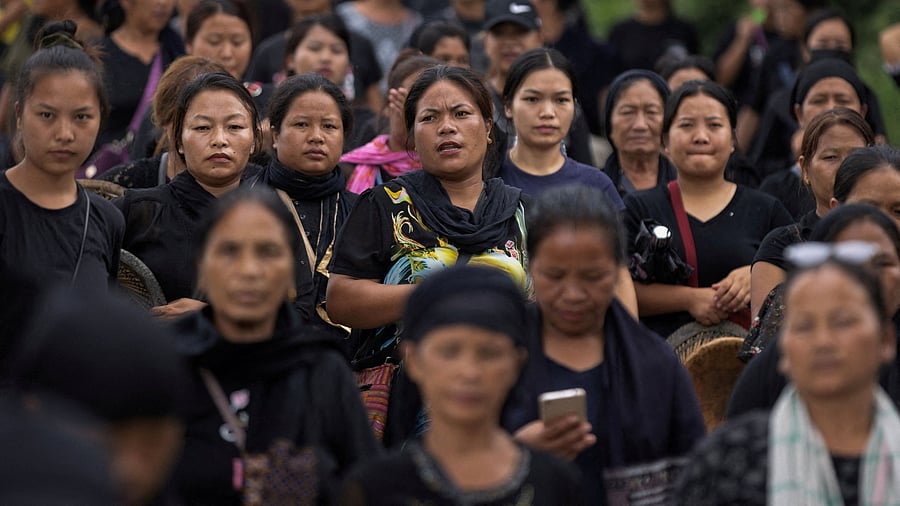
Kuki women leave after attending a protest against the alleged sexual assault of two tribal women, in Churachandpur district in Manipur.
Credit: Retuers Photo
Why, and how, does Mizoram get involved in the ongoing ethnic (and religious) strife that is on for over three months in Manipur? The Kukis and Zomis in Manipur are ethnically related to the Mizos, the dominant community in Mizoram. The Mizos, in turn, are ethnically related to the Chins in Myanmar and the Kuki-Chins in Bangladesh.
Together they all belong to the greater Zo community, speak a similar language, have common ancestry and parallels as regards their cultures and traditions. These latter groups are predominantly Christian, and hence have a strong bond with the Mizos in Mizoram, a predominantly Christian state, like Nagaland. The Chief Minister of Mizoram, Zoramthanga, is a Mizo.
In Manipur, the Meiteis, a Hindu community, are the majority and overwhelmingly numerically dominant. But it is interesting that the Meiteis are found in small numbers in Mizoram too, and many have started fleeing from the state. Similar fleeing of the Kukis from Manipur to Mizoram has happened. Also, there are the Naga groups in different pockets in Manipur. The neighbouring state of Nagaland has 17 officially recognised Naga groups.
It is exasperating, and quite a disquiet, to note the presence of ethnic groups that are dominant in one state, being minorities in a neighbouring state. Such an existence has given rise to very foreboding situations and added to the already prevailing ethnic conflicts in India’s North-East.
It is not just that the Indian states in the region share common borders. There are international borders too in the area, as Bangladesh and Myanmar adjoin the Indian states. Different communities/tribes/groups of people have lived in the regions that are the focus of our discussion for eons. Such inter-state and international habitations of ethnic groups across states/countries are come across elsewhere in the world too.
One of the most interesting and classic instances of a single ethnic group, who regard themselves as a single nation, and inhabit more than one country, is that of the Bedouin (found in Syria, Algeria, Morocco, Libya, Egypt, Israel, and so on). Such situations come about because free ranging groups of people, or partially or fully settled groups of people, got divided into different states or countries because of the coming in of boundaries and division of territories.
What would have been the scenario like if these borders between states and countries had not come up? We would undoubtedly have diverse groups living in enclaves, either quite separated or adjoining each other either as small groups or larger ones, but sans the borders dividing them; the question of majority/minority or dominance/subservience would not, probably, have had the same kind of meaning or effect as has happened due to the drawing of borders between states and countries.
Borders that formed between enclaves of diverse inhabitants and made groups of people as dominant and/or majority groups have resulted in the hegemony, where the traditions, customs, practices, and mores of that group have gained significance. These traditions and customs prevail extensively when compared to the practices of the smaller groups in that same area. Invariably, the dominant group makes claims to being the ‘original inhabitants’ and the ‘natives’ of the state/country concerned.
Quite often co-habitants develop similar institutions and social and cultural practices despite the differences and diversity between them, and this is quite apparent in multicultural societies. Amitav Ghosh argues that “it is … the vitality of the place itself that creates commonalities between the people who dwell in it, no matter what their origin” (The Nutmeg’s Curse, page 221). But sadly, it is the differences that often come to the fore, and similarities remain latent.
Here, it is pertinent for us to dwell on the facets of claims that groups make as regards being the autochthons and natives of a given state/country. By extension, the non-dominant groups are labelled ‘immigrants’, ‘foreigners’, and ‘outsiders’. Prior to ‘Out of Africa’, and the spread of Homo sapiens sapiens to the different parts of the world, somewhere between 80,000 and 50,000 years ago, there were no fully evolved human beings in any part of the world. Subsequent to a group of them leaving Africa, different parts of the Earth got populated gradually.
All the physiognomic and phenotypical differences that we find among humans today, including skin colour, hair texture, and colour of the eyes came about as a result of where people settled.
To put it tersely, no human group can make a concerted claim as regards nativism and try to make an ‘other’ an immigrant, or foreigner or outsider. Ghosh endorses this when he says “except for one small part of Africa, nowhere on Earth can people be said to be truly native, in the sense of having come into being on that soil” (The Nutmeg’s Curse, page 221).
(M A Kalam, a social anthropologist, is Distinguished Fellow, The Peninsula Foundation, Chennai.)
Disclaimer: The views expressed above are the author's own. They do not necessarily reflect the views of DH.